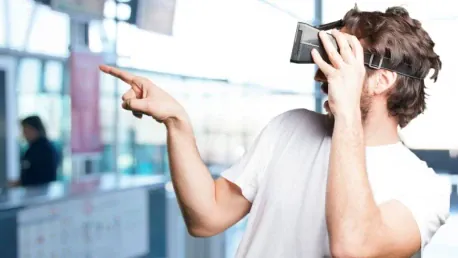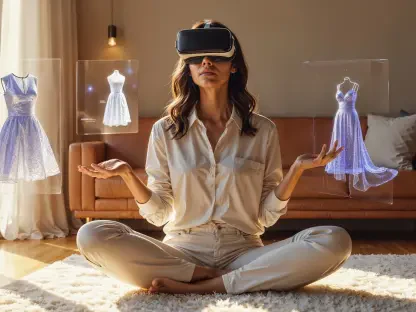The realm of augmented reality (AR), once considered a distant science-fiction concept, has swiftly transitioned into a tangible tool utilized by businesses for product sales. AR’s early adopters were predominantly gamers and metaverse enthusiasts. However, the technology is no longer confined to these niches. As consumers increasingly seek immersive experiences and the ability to interact with products and brands before purchasing, AR has emerged as a significant player in the retail landscape. This technological enthusiasm is projected to drive substantial economic value, potentially up to $5 trillion by 2030, with leading companies experimenting with metaverse commerce across various domains such as home décor, food, fitness, and apparel.
Understanding AR Shopping
The Concept of AR Shopping
AR shopping leverages technology to enable customers to virtually try on and test products using an electronic device, such as a smartphone or VR headset. This could either simulate the experience of being in a physical store interacting with products or visualize how products would look in a customer’s home or, in the case of fashion, on their body. AR aids marketers by allowing pre-purchase engagement such as virtually trying on clothing or overlaying furniture in a living space to assess compatibility and size.
The multiplicity of applications makes AR a versatile tool, transforming how consumers approach shopping. For example, in the automotive sector, a customer can visualize a car in their driveway, change its color, or explore its interiors, all from the comfort of their home. Similarly, in real estate, potential buyers can take virtual tours of properties, examining layouts and features before deciding to visit in person. This integration of AR into shopping experiences not only enriches consumer interactions but also provides businesses with valuable insights into customer preferences and behaviors, facilitating more targeted marketing strategies.
Benefits for Marketers and Consumers
For marketers, AR shopping provides a unique opportunity to engage customers before they make a purchase. This pre-purchase engagement can significantly reduce return rates and increase customer satisfaction. Consumers benefit from the ability to make more informed decisions, as they can see how products will fit into their lives before committing to a purchase. This interactive experience can lead to higher conversion rates and a more enjoyable shopping experience.
Furthermore, AR offers the potential for creating memorable brand interactions. By leveraging AR, businesses can craft unique experiences that stand out amid the digital noise, fostering a deeper connection with their audience. For instance, beauty brands have developed AR makeup try-on experiences that not only demonstrate product usage but also allow customers to experiment with different looks, enhancing brand loyalty and engagement. For consumers, the ability to visualize products in their real-world context reduces the uncertainty associated with online shopping, making it easier to choose items that truly meet their needs and preferences.
Current and Future Market Dynamics
Market Valuation and Growth Projections
The AR market, valued at $40.12 billion by 2022, is projected to balloon to $1.19 trillion by 2032. This anticipated growth is spurring significant investments from major tech companies. Google, for instance, acquired Raxium in 2022 to boost its smart glasses prospects, while Apple acquired AR headset startup Mira following its release of the Vision Pro VR headset.
Investment from these tech giants underscores the burgeoning potential of the AR market, particularly in retail. As AR technology becomes more integrated into smartphones and other consumer devices, its adoption is expected to rise sharply. Businesses across various sectors are recognizing the value of AR in enhancing their customer engagement strategies and are investing in AR infrastructure and tools accordingly. This growing adoption is not just confined to large corporations; small and medium-sized enterprises are also exploring AR solutions to differentiate themselves in a competitive market landscape, indicating a wider acceptance and utilization of AR in everyday business operations.
Technological Advancements and Accessibility
Advancements in smartphone cameras have made AR shopping more accessible. Enhanced hardware and software have enabled a variety of consumer-friendly try-on options, making AR an appealing technology for marketers. Beauty brands are increasingly exploring AR/VR, allowing potential customers to try different colors and shades via a smartphone camera.
As technology progresses, the accuracy and realism of AR experiences continue to improve. Features like LiDAR and Time-of-Flight (ToF) sensors in smartphones facilitate more precise depth sensing, leading to more realistic AR overlays. Additionally, software advancements in machine learning and computer vision are enhancing the ability of AR applications to recognize and adapt to different environments, creating more seamless and intuitive user experiences. These technological strides are lowering the barriers to AR adoption, making it easier for consumers to engage with AR shopping experiences and for businesses to implement AR solutions in their marketing strategies.
Trends to Watch in AR Shopping
Social Media Apps and Camera Filters
The pandemic has accelerated online interaction, pushing brands to innovate in engaging consumers via e-commerce and social commerce channels. Snapchat and Instagram have been early proponents, offering AR filters for brands. For example, Snapchat collaborated with OPI to create a filter for trying on nail polish colors. To leverage this trend, marketers can use tools like SnapAR Lens Studio and Meta Spark.
The integration of AR in social media platforms also encourages more organic and spontaneous interactions with brands. By embedding AR filters within everyday social media usage, platforms are creating opportunities for consumers to engage with branded content in a fun and interactive manner. Brands can tap into this trend to develop creative and shareable AR experiences that resonate with their audience. For instance, cosmetic brands can use AR filters to allow users to try on new makeup looks, and apparel brands can offer virtual fashion shows. These innovative approaches not only enhance consumer engagement but also amplify brand visibility and reach within the social media space.
Virtual Try-On
Virtual try-ons are prevalent in fashion and beauty, allowing customers to visualize products before purchase, which can reduce return rates. For example, integrating AR into social commerce platforms like Instagram/Facebook Shops can streamline the customer journey. This trend is particularly beneficial for items like clothing, makeup, and accessories, where seeing the product on oneself can significantly influence purchasing decisions.
The benefits of virtual try-ons extend beyond just reducing return rates. This technology can also enhance the overall shopping experience by providing customers with a more personalized and interactive journey. For instance, virtual try-ons can be integrated with AI-driven recommendations to suggest items that complement the user’s style or previous purchases. This not only helps customers find products they love but also increases basket sizes and overall sales for retailers. Additionally, virtual try-ons can be used to gather valuable data on customer preferences and behaviors, enabling brands to optimize their product offerings and marketing strategies.
Virtual Showroom
Virtual showrooms permit customers to place AR objects in their real-world environment, such as placing furniture in a living room. This functionality, akin to virtual try-ons, involves using Amazon Sumerian for AR-enabled Amazon listings. It’s crucial to ensure the AR item accurately communicates with the user’s environment to manage expectations. This trend is particularly useful for home décor and furniture brands, allowing customers to see how items will fit into their spaces.
The concept of a virtual showroom goes beyond just static placements; it can also include interactive elements that allow customers to explore different configurations and customization options. For example, a virtual showroom for a furniture store could enable users to change upholstery, move items around the room, and even simulate different lighting conditions. This immersive experience helps customers make more informed decisions and feel more confident in their purchases. As a result, businesses can benefit from higher conversion rates and reduced return rates, while customers enjoy a more engaging and satisfying shopping journey.
Improved AR Hardware
Innovations in mobile technology, such as depth-sensing hardware (LiDAR and ToF), enhance AR capabilities. The mobile AR market revenue is expected to nearly triple from $12.45 billion in 2021 to $36.26 billion in 2026. Companies like Google, Microsoft, and Lenovo are also developing smart glasses, though widespread availability remains a few years away. Until then, mobile AR technology continues to dominate, providing a robust platform for AR shopping experiences.
The enhancements in AR hardware are not just limited to smartphones; wearable devices like smart glasses are also on the horizon. These devices promise to deliver more immersive and intuitive AR experiences by freeing users from the constraints of holding a smartphone. Although still in the early stages, the development of smart glasses by companies such as Google, Apple, and Microsoft indicates a future where AR could seamlessly integrate into daily life. This progression in AR hardware will likely open up new possibilities for AR applications in retail and beyond, making it an exciting area to watch in the coming years.
AR Mirrors for In-Store Shopping
AR mirrors in-store use either digital screens with motion sensors or digital displays with cameras to create real-time AR experiences. The smart mirror market, valued at $3.8 billion in 2022, is predicted to grow to $9.1 billion by 2032. Major brands like MAC Cosmetics use these mirrors to offer virtual makeup trials. This trend enhances the in-store shopping experience, providing customers with a high-tech way to try on products without physical contact.
The implementation of AR mirrors in retail environments represents a significant shift in how stores can interact with and engage customers. These mirrors can be programmed to provide personalized recommendations, product information, and even step-by-step tutorials, enriching the customer’s shopping experience. For beauty brands, AR mirrors can offer real-time virtual makeup trials, helping customers find the perfect shades and products without the need for physical samples. This technology not only enhances the in-store experience but also aligns with shifting consumer preferences towards contactless and tech-driven shopping solutions, potentially driving higher foot traffic and sales.
Gamifying In-Store Shopping with AR
Brands like Tesco are using AR to gamify in-store shopping, enhancing customer engagement. Tesco, for instance, collaborates with Engine Creative, creating AR experiences within the Tesco Discover app to provide product information and gamify product scanning. This trend not only makes shopping more fun.
Gamification leverages AR to transform mundane shopping tasks into interactive adventures. By incorporating game elements such as points, rewards, and challenges, brands can create a more engaging and enjoyable shopping experience. For instance, a grocery store might introduce an AR scavenger hunt, where customers can use their smartphones to find and scan specific items, earning discounts or prizes for their efforts. This approach not only makes shopping more entertaining but also encourages customer loyalty and repeat visits. Gamification through AR also provides valuable data on consumer behavior, helping retailers better understand and cater to their customer’s preferences and habits.
Conclusion
Augmented reality (AR), once thought to be the stuff of science fiction, has rapidly become a practical tool for businesses to enhance product sales. Initially, AR was a playground mainly for gamers and metaverse aficionados. However, this technology has broken out of those niche confines. Nowadays, consumers crave immersive experiences that allow them to engage with products and brands prior to making a purchase. As a result, AR has become an influential force in the retail sector. The enthusiasm around this technology is not just hype; it’s expected to generate substantial economic value. Predictions suggest that AR could contribute up to $5 trillion to the economy by 2030. Leading companies across various industries, from home décor to food, fitness, and apparel, are already experimenting with metaverse commerce. This ongoing innovation in AR technology holds the promise of revolutionizing how consumers shop, making it easier and more engaging to explore and interact with potential purchases. AR is not just enhancing the consumer experience but also creating new opportunities for businesses to connect with their audiences in more meaningful and interactive ways. This shift represents a significant evolution in the retail landscape, driven by a blend of technological advancement and changing consumer expectations.








